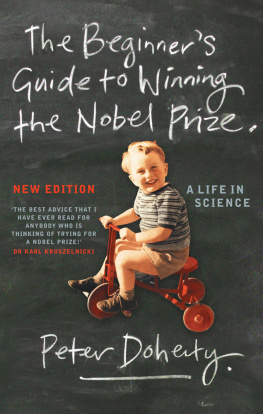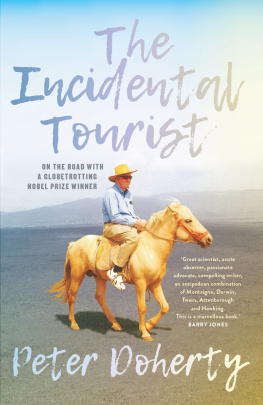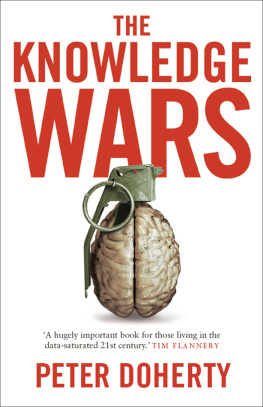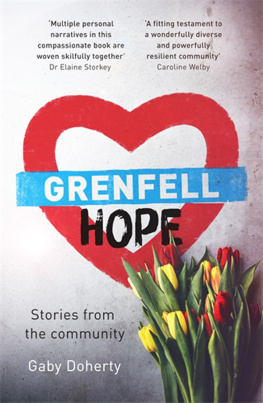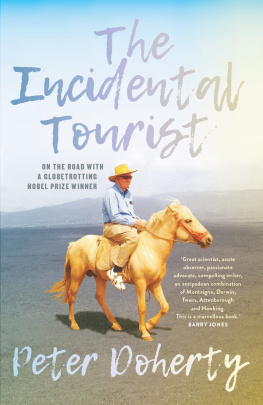Contents
An insiders plague year

MELBOURNE UNIVERSITY PRESS
An imprint of Melbourne University Publishing Limited
Level 1, 715 Swanston Street, Carlton, Victoria 3053, Australia
www.mup.com.au

First published 2021
Text copyright Peter Doherty, 2021
Design and typography Melbourne University Publishing Limited, 2021
This book is copyright. Apart from any use permitted under the Copyright Act 1968 and subsequent amendments, no part may be reproduced, stored in a retrieval system or transmitted by any means or process whatsoever without the prior written permission of the publishers.
Every attempt has been made to locate the copyright holders for material quoted in this book. Any person or organisation that may have been overlooked or misattributed may contact the publisher.
Text design and typesetting by Megan Ellis
Cover design by Philip Campbell Design
Cover photo by William Hung
Printed in Australia by McPhersons Printing Group

9780522877519 (paperback)
9780522877526 (ebook)
To the frontline healthcare professionals across the planet who have given their all through this pandemic
CONTENTS
PRELUDE
The title of this book is, of course, derivative of that used by Daniel Defoe in his 1722 classic, A Journal of the Plague Year. An alternative might have been Life in the Time of COVID, taking inspiration from Gabriel Garcia Marquezs classic Love in the Time of Cholera, but that great novel goes so much to the heart of who we are that even to touch it at the margins would be an exercise in massive disrespect.
Like Defoes account, rather than being about imagined lives, this is partly a personal narrative of the experience of living through the first year of COVID-19; it certainly wont be the last. And its also a direct record of what I wrote and published, either in print or online, through that year. It is in no way an attempt to write a comprehensive account of what happened with COVID-19, either globally or locally. Ill leave that to the journalists, the sociologists, the public health professionals and, ultimately, the medical historians.
Published initially on the Doherty Institute website, my weekly Setting it Straight column makes up , the biggest component of the book. But though these essays were written to discuss and, hopefully, open out in an amiable way the whole area of infection and immunity to a lay reader, they arent intended as some sort of didactic exercise. Their purpose is to inform, to intrigue, to entertain and to make it just a little easier for those who like to have some background understanding of whats happening in this difficult time. The overall story they tell is incompletecan it ever be otherwise?and they will continue through 2021 and, likely, 2022.
As Ive worked on aspects of infection and immunity for almost six decades, I am an insider. In the present context, though, that description also reflects that the Doherty Institute has been at the heart of the enormously successful Australian response to COVID-19. As a consequence, without going into areas that might violate medical privacy or be politically sensitive for one or another reason, I can give you just a little insight into how it was handled by the professional scientists and infectious disease/public health doctors who were at the centre of our laboratory-based approach. You may find that intriguing, especially when it comes to meeting, however briefly, some of the modest heroes of what happened here.
Part 1
EARLY DAYS
1
THE LONG ROAD TO DECEMBER 2019
After celebrating my seventy-ninth birthday in October 2019, December was my psychological cut-off date for bringing fifty-seven years of direct involvement in infectious disease research to a final conclusion.
Having returned to Australia from the United States to join the Department of Microbiology and Immunology at the University of Melbourne (UniMelb) Medical School in mid-2002, Id continued through that decade with a pattern of direct, though progressively decreasing, involvement in laboratory-based research that initially involved spending nine months each year in Melbourne and three months at St Jude Childrens Research Hospital (SJCRH) in Memphis, Tennessee, where Id relocated from the Australian National University (ANU) in 1988 to head the Department of Immunology. These United States visits from 2002 were generally split into three to four trips a year, with that frequently involving an exhausting round-the-world itinerary (often with my wife, Penny) to give invited lectures in Asia or Europe. That type of travel is part of the unofficial science ambassador/global citizen role that senior Australian scientists fulfil, and in my case at least, all costs were paid from international sources.
Moving to the great city of Melbourne, I left a modern laboratory in a recently constructed research tower at SJCRH to relocate to a drab brutalist modern 1970s concrete structure on Royal Parade in Parkville. That buildingits still standing, between the original Howard Florey Institute and the Kenneth Myer neuroscience facility had been refurbished inside and, although reasonably functional, was in serious need of replacement. On the ground floor, along with the usual sterilisation (autoclaves, like big pressure cookers), glass-washing and storage facilities that are central to this type of operation, there was a separate, secure entrance to the affiliated Microbiological Diagnostic Unit (MDU), which the university Micro department (as its colloquially known) ran for the Victorian Government.
Microbiology in the MDU context meant bacterial and fungal diseases. Virus diagnostics was, on the other hand, the responsibility of the Victorian Infectious Diseases Reference Laboratory (VIDRL), located less than a kilometre away in North Melbourne. Both operated a service where samples from medical practitioners and hospitals would be dropped off by mail or courier to a receptionist, or after hours into what resembled a bank night-safe; they were then processed rapidly for culture and isolation or, more commonly now, for the detection of pathogen genome by PCR (polymerase chain reaction). Many of the more routine diagnostics are, in the Australian context, performed by private pathology laboratories, but the key roles of the MDU and VIDRL are to set the standards and tackle the tough ones. Public health laboratory services are state based in Australia and linked via the national Public Health Laboratory Network (PHLN) standing committee with the current chair and deputy chair being Ben Howden and Mike Catton from the Doherty Institute. There is no facility equivalent to the US Centers for Disease Control and Prevention (CDC), that resources a national strategy for dealing with pandemic situations.
Clinical infectious disease (ID) operations in Parkville (where the University of Melbourne is located) are centred in the Victorian Infectious Diseases Service (VIDS), comprised of hospital-employed ID physicians who both care for patients and conduct research at Royal Melbourne Hospital (RMH) across the street from the old Micro building. Australia does not have a system of university-owned or -controlled hospitals, so RMH answers to the Victorian Government as part of a structure called Melbourne Health. Nonetheless, it is a major teaching hospital, and many physicians have traditionally had adjunct university appointments.



